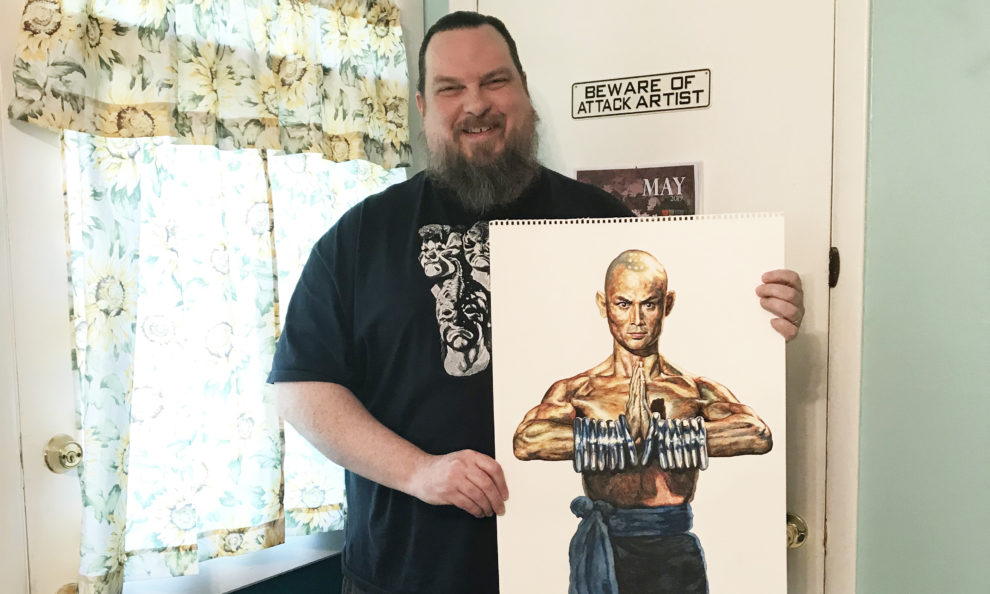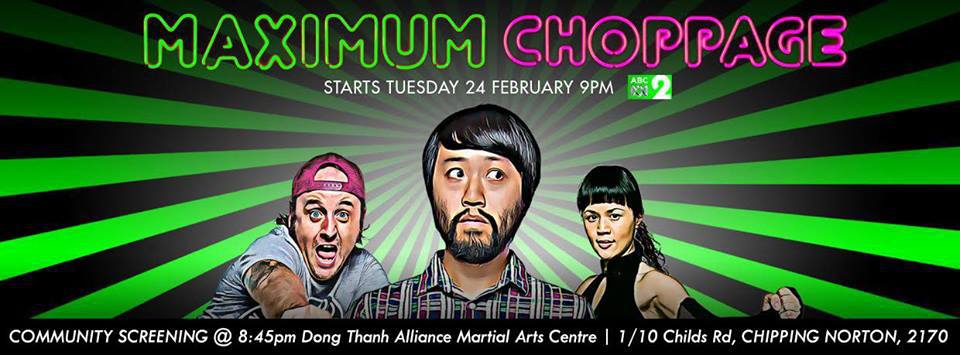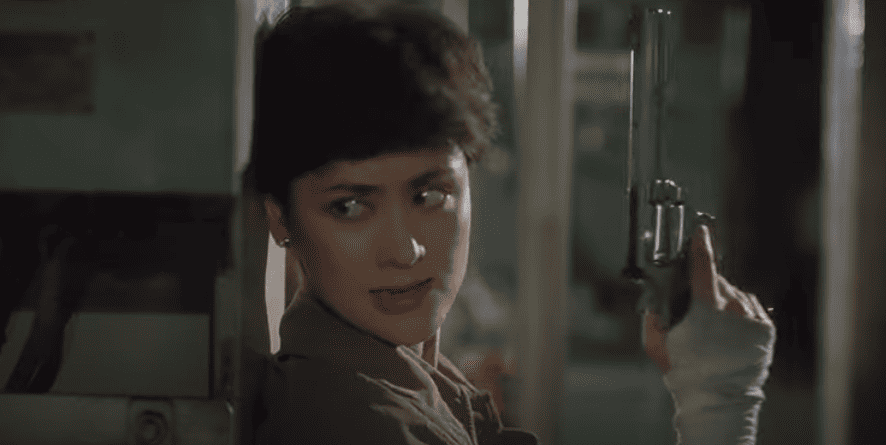Robert P. O'Brien is an American self-taught artist/illustrator that works in various mediums, creates shirt designs for 36styles.com and helps run the Kung Fu Fandom Forum hosted by that site. Nicknamed “Kung Fu Bob” because of his love of that cinema genre, in recent years he has created a lot of new, original artwork for DVD and Blu-ray film releases, in addition to book and CD cover art. In 2020 he recorded his first audio commentary for 88 Films' release of Jet Li's THE MASTER and also joined Hong Kong cinema expert Brandon Bentley for a commentary on 88's Blu-ray for NEW FIST OF FURY.
We speak with him about how he begun martial arts, drawing how he combines the two, the procedure he follows every time he deals with an artwork, his work with 88 Films, Midori Implus and Arrow, and many other topics.
How did your interest with Asian cinema begin?
I was always interested in fantasy, horror and sci-fi since I was a kid, and my parents took me to watch a lot of movies. However, my father was not interested in Asian cinema at the time, so I was not introduced to it early on. I did see a few minutes of “Five Deadly Venoms” on TV, and when I saw the masks, I thought it was a horror movie and I got very excited. But as soon as the beginning of the movie was over and they weren't in masks anymore, I lost interest.
When I was teenager, I got jumped by a bunch of guys and was beat up pretty badly, and a guy I was working for, Carl, who was like a big brother to me, said “Now you're living in fear and you don't have confidence. Maybe you should practice martial arts”. I was reluctant in the beginning, because I did not do any sports, I preferred to read and draw. But then he told me that Bruce Lee, who was his inspiration, was practically blind without contact lenses on, and he had all these little physical problems, one leg was shorter than the other, but he overcame all of them and became the greatest. It is funny when I think about it now, but what I actually replied to him was, “I've seen his picture on T-shirts but I don't really know who he is”. (laughs) He told me that I had to see Bruce Lee, and that as soon as I got off from work I should rent a video, and he would even pay for it if I didn't have the money. I rented “Enter the Dragon” and it just changed my life. It's kind of a B-movie version of a James Bond film, but fantastically entertaining. Bruce Lee jumped off the screen and it was not like anything I had seen before, I was so inspired! I had always enjoyed action films, but the only martial arts I'd seen were from Chuck Norris, Sho Kosugi's ninja films and Elvis! I'd never seen a martial artist like Bruce Lee before. When I saw him using the nunchaku I thought, “I have got to learn to do that, cause it is the coolest thing I've ever seen”. Within a week, I had a pair of nunchaku and basically I taught myself how to use them. I watched the “Enter the Dragon” video in slow motion and then I'd run out to the back yard and give it a try. One move at a time. That's how I got into martial arts, and then I wanted to see every Bruce Lee movie, which led to Hong Kong films, and Japanese samurai cinema, and that's what sparked the whole thing and got me interested in Asian cinema. This was about 1985.
Do you still practice martial arts?
I do, yes. It's kind of funny that I am so attracted visually to Chinese styles, I just think kung fu looks amazing. However, I was told early on, that the thing to do is look for a good teacher, that it is more important than the style. And every time I met a teacher I wanted to work with, they just happened to almost always be exponents of Japanese arts. I dabbled in a lot of different things, but the style I studied the longest is Shinowara Ryu Jujitsu, which is basically the grappling art of the samurai. It's not like Brazilian jujitsu- which is cool, but totally different. Shinowara is an ancient form- it's essentially the way the samurai would fight with their katana, but empty-handed. Plus there are a lots of throws, and unlike many forms of jujitsu, it has plenty of kicks in it. My sensei had also studied Hapkido and White Crane kung fu, so he'd throw in techniques from those styles too. I also dabbled in a lot of other things, a little bit of Tai Chi, Wing Chun, Muay Thai, some boxing and wrestling. I pretty much followed the philosophy of Jeet Kune Do, to take what works best for me, my body type, and adapt my own strengths to use different styles. I am not one of those people who says, “This style is the best!”.
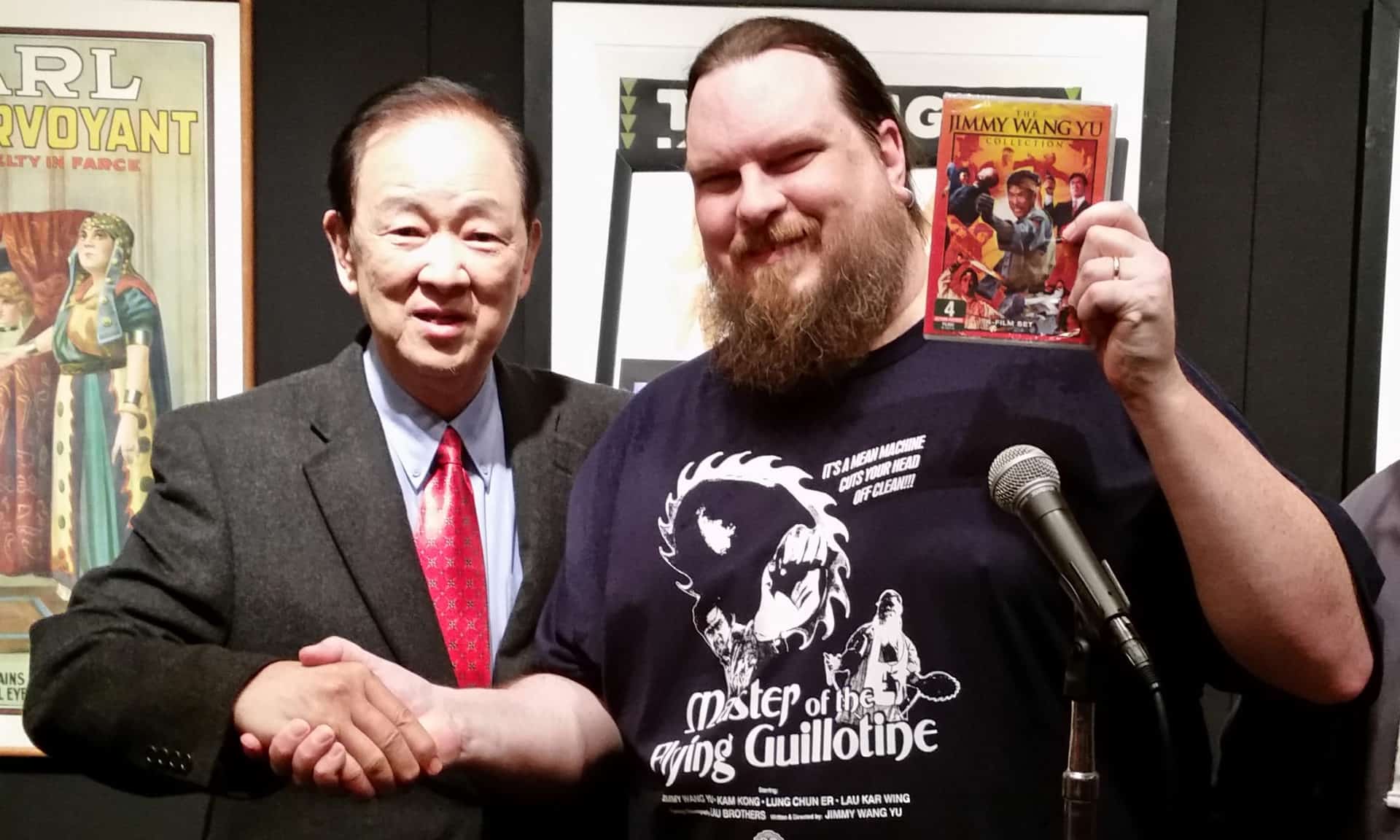
And when did you start drawing?
I started as soon as I could hold a crayon, when I was just 3 or 4 years old. My mom is not an artist per se, but is very imaginative and good with all kinds of crafts and has a lot of talent with colors and putting things together. The earliest lesson I remember is when I was coloring in a Disney coloring book and I asked her how to make the color of water. She told me that a lot of people think that water is blue because it is reflected by the sky, but if you put a little green and little purple and then you go over that with blue, then you get different colors. It was like magic, a whole world opened up for me realizing that you can take two basic colors and make a third color that's completely different from that. I have not stopped drawing since then.
And when did you start drawing martial arts?
As soon as I got involved with martial arts, I started drawing ninjas and samurais, in a kind of cartoonish way at first, and later on, a bit more serious pencil drawings. I love to draw Bruce Lee, he's so striking looking. He has such an amazing physique. If you look into a medical book of anatomy, just the muscle figure without the skin, Bruce Lee almost looks like that. His muscles are so well-defined that you could study anatomy just by looking at his body. I found it fun to draw him and I got into Sonny Chiba pretty early too. I love the “Street Fighter” movies, and I did a lot of drawings of him. I started doing more martial arts drawing when I was 15 or 16 years old.

Do you feel there is common ground between martial arts and drawing?
They are both expressions through physicality and they are both arts, even if they are different kinds of art. Kung fu basically means “a skill”, instead of a fighting style as I thought in the beginning. I met Lo Meng who played Toad in the Five Venoms, in 2007 at a Lifetime Achievement event put on by Rich Hopkins in Philadelphia, Pennsylvania. I thought that since I'd be meeting him I should get something special autographed. So, I drew some pictures that I'd like to have hanging up, just for that purpose. When my wife saw them, she said that I should get prints of these because people will love them, and maybe get a table at the event and sell them. I followed her advice and people really seemed to love them and many asked “Will you also be drawing the other Venoms?” I thought that since Lo was a star, he would be polite, but that he probably got stuff like that all the time, and it wouldn't be a big deal. But when I gave him the art, he was actually very moved. He stood up from the table and put his hand on my shoulder, and said, “You have good Kung Fu… here” and he mimicked drawing with his other hand. Well, I thought that was just one of the coolest compliments I had ever received… from one of the Five Venoms no less.
So anyway, my point is- I think they really go hand in hand. I got into martial arts because I wanted to get my confidence back and not be afraid anymore. Training kind of went against what I felt naturally though. I'm a peaceful person, and the thought of learning how to hurt somebody did not really sit well with me, but it seemed better than getting hurt again. So, I got into it, and what I quickly found was that I loved “the art of it”, and it was something that had felt so foreign to me. It made me feel alive in a way I had never felt before, so I quickly developed a love for martial arts and it's really different from anything else I have ever experienced. I think it is the same as drawing. You create something from nothing. If you stand still, then nothing is happening. But if you take a stance and throw a kick, you are creating a motion, which is the same as using a pen or a paintbrush. The piece of paper is like standing still and then you have to move to create something. The movement of both a sword and a brush are both called strokes. And it is coming from within you, the same place where love, or writing, or anything would come from… everything comes from our spirit. Therefore, I really feel there is a deep connection between creating images in two dimensions and practicing the physical movements of martial arts in three dimensions.
What is your procedure, when you start drawing?
Most of the things I have done, I was already familiar with. But whether it is something I have never seen, or it's something I have seen 50 times, the first thing I want to do is watch the film I'll be doing the artwork for. To refresh my memory, and to align myself mentally with the spirit of that film, what it means to me and what it is saying. What the characters feel like. Sometimes the character feel like specific colors, or a texture. I will watch the film, often taking notes, observing the moments that a character shines in the film for example, and I feel that I definitely have to represent that moment, scene, or feeling in the artwork. It's interesting, because some times, there's not a central image that comes to mind when I watch a film, and other times, there are so many images that it's hard to choose what to keep and what to lose. The number one thing I do is imagine: if I saw any poster of this film, as a fan, what would I want it be? If I could go to a shop and see a poster that will make me love this film, what would it look like? Since I am such a big fan of the films, I think that if this would make me happy, hopefully it will have the same impact to other fans, or attract people that have not seen the film.
Sometimes I have an instant idea, I know exactly what I want to do from the beginning and other times, I have to work it out in my head. Ordinarily, I will pull hundreds of reference pictures from the film so that I can see all the relevant details. For example, exactly what a guy's shoes look like in one shot. A good shot of the actors in profile, three quarters, straight on. I pull all of these together, and sort of have them on a computer screen in front of me. Then I usually start sketching on paper and it is almost like having models there, posing for me. So, for the most part, I come up with an idea eventually, and that is the main concept. Some companies, however, say, “send us a bunch of sketch ideas and we will pick what we want”. My initial idea is usually the best, then I try to come up with alternative designs just to give them choices. Inevitably, it seems that most of the time, they do not pick the one I think is best. (laughs) Over the years, I found that the thing I need to do is follow my instinct about the best piece, send it to them and tell them that if they do not like it, I could send them some more. But that this is the best idea in my opinion. Some companies say “We know you love this movie, we trust you, just go for it” and don't even ask for sketches. Usually the companies that request sketches are very happy with what I send; sometimes, they ask for certain changes. Some of the people in charge want to see something sexier, or cuter, or to emphasize a certain actor or event in the film. Once I get the approval from the them, I usually sketch it out with a pencil and for the most part I use Copic markers and I start drawing away.
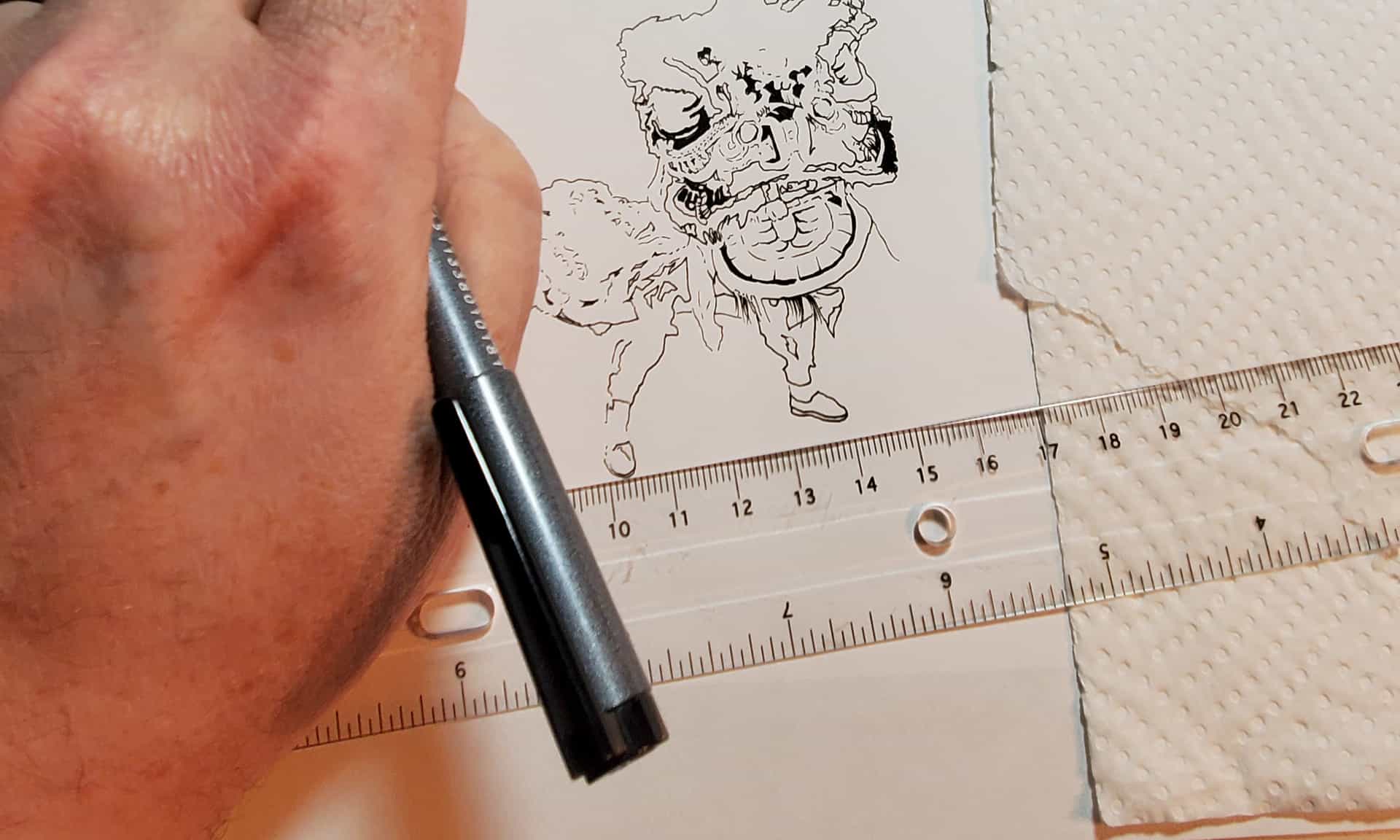
Have you ever had to do artwork for a film you do not like? Or draw something about a film you like but you end up not liking the work?
Yes, it is like any other job, you have to try to do your best and just do the work, to the highest of your ability. When I see a movie I do not like, I think what other people do like about it, what is the thing about it I find the least annoying (laughter). Sometimes, I will look around at reviews by “regular” people- not critics- and see what they say and what they like about it. Then, I will try to cater to what the people who do like the film find appealing about it.
In “8 Diagram Pole Fighter”, of which I am a huge fan of, I did not like how my work turned out. I didn't think it came near properly representing the film or the dramatic impact that the movie had. I was actually going to throw it away and a friend saw it and said, “Are you crazy? This is amazing”. But I still had my doubts. The director, Lau Kar Leung is my favorite kung fu performer and director of kung fu cinema, so maybe I had too high expectations of myself, thinking “How I could achieve with my art what he achieved with his?” But I tried and it turned out to be one of my most popular pieces of art. You never know…
So, are you your own worst critic?
You have to be as an artist if you want to grow. You have to look at your work and think what you could have done better. The same with martial arts. If on your last day on Earth you think you know everything there is to know about martial arts, then you are the worst student ever. Every piece of knowledge that you get is a drop of water in the ocean. There is always so much to learn, and any kind of art is that way. If you are a master swordsman, the only reason you have reached that level is because you always strive for what you think you cannot achieve. I look at every piece of art I have finished and I can tell you a hundred things wrong with each one. And I am thinking, maybe next time there will only be 99 things wrong, I just need to continue trying to be better. I love constructive criticism, because that is how I grow.


